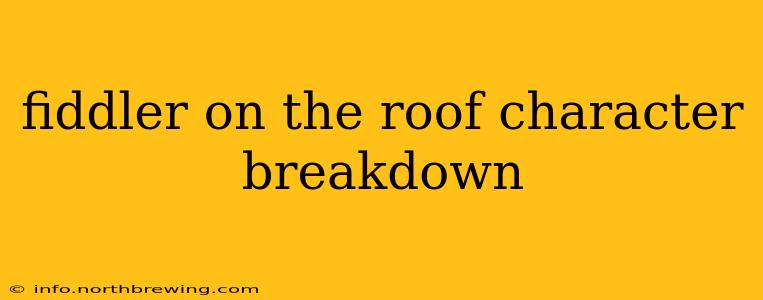Fiddler on the Roof, a timeless musical masterpiece, captivates audiences with its heartwarming story, memorable songs, and richly developed characters. This character breakdown delves into the complexities and motivations of the individuals who bring this beloved tale to life, exploring their relationships and contributions to the narrative. Understanding these characters unlocks a deeper appreciation for the play's enduring themes of tradition, change, and family.
Tevye the Milkman: The Heart of the Story
Tevye, the protagonist, is a poor milkman living in the small Jewish village of Anatevka. He's a deeply religious man, clinging steadfastly to tradition, yet grappling with the changing times. His unwavering faith is constantly tested by the rebellious actions of his daughters and the looming threat of anti-Semitism. Tevye's internal conflict—between tradition and modernity, faith and doubt—forms the emotional core of the musical. He's both stubborn and endearing, his humor and resilience making him a relatable and sympathetic figure, despite his sometimes frustrating adherence to tradition.
What are Tevye's most defining traits?
Tevye's defining traits include his strong faith, his love for his family, his humor, his stubbornness, and his willingness to question, albeit reluctantly, his deeply held beliefs. His conversations with God are a highlight, revealing his internal struggles and his attempts to reconcile his faith with the challenges he faces.
Golde: Tevye's Steadfast Partner
Golde, Tevye's wife, is a pragmatic and practical woman, a counterpoint to Tevye's more idealistic nature. While sharing his faith, she's less sentimental and more focused on the immediate needs of their family. Her strength and resilience are evident in her unwavering support of Tevye, even when she disagrees with his decisions. Her evolution throughout the musical shows a willingness to adapt, albeit cautiously, to the changing world around her.
How does Golde's role differ from Tevye's?
Golde's pragmatism contrasts with Tevye's idealism. While Tevye often relies on God and tradition for answers, Golde focuses on practical solutions and ensuring the well-being of her family. This doesn't mean a lack of faith but a different approach to life's challenges. Her character arc emphasizes the importance of adapting to change within the confines of one's beliefs.
The Daughters: A Generation Gap
Tevye's five daughters, Tzeitel, Hodel, Chava, Shprintze, and Bielke, represent the clash between generations and the gradual erosion of tradition. Each daughter challenges her father's authority in her own way, leading to conflict and ultimately, a shift in family dynamics.
How do the daughters' choices reflect the changing times?
- Tzeitel: Challenges arranged marriage, choosing love over tradition.
- Hodel: Marries for love, demonstrating a willingness to embrace change.
- Chava: Makes the most radical choice, marrying outside their faith.
- Shprintze and Bielke: While less central to the plot, their very existence underscores the growing family size and the generational shifts occurring in Anatevka.
Their individual choices symbolize the broader societal changes impacting the community, pushing against the rigid confines of tradition and paving the way for a more modern approach to life and love.
Yente the Matchmaker: The Village Gossip
Yente, the village matchmaker, provides comedic relief and adds a layer of social commentary. Her role highlights the importance of marriage within the community and the pressures faced by young women. Her sometimes meddling nature underscores the limitations placed upon women in that time and culture, but her loyalty to the community is undeniable.
What is Yente's role in the community?
Yente acts as a social connector and, in her own way, a confidante. Her gossip and matchmaking reflect the societal expectations and dynamics within Anatevka. She’s a crucial piece of the social fabric, even if her methods aren't always appreciated.
Perchik and Motel: Representing Modern Ideas
Perchik, a student, and Motel, a tailor, represent the emerging modern world. Perchik introduces new ideas about education and social justice, challenging Tevye's traditional worldview. Motel's ambition to marry Tzeitel, defying the arranged match, reflects a desire for self-determination. They both contribute to the generational shift and encourage Tevye's daughters to challenge societal norms.
How do Perchik and Motel influence the main characters?
Perchik represents a challenge to Tevye's beliefs, causing him to question his own convictions and the status quo. Motel, through his pursuit of Tzeitel, acts as a catalyst for Tevye's eventual acceptance of change.
The Wider Community: A Microcosm of Change
The wider community of Anatevka plays a significant role in illustrating the setting and the pressures faced by the Jewish community. The looming threat of persecution from the outside world adds another layer of complexity to the story, forcing the characters to confront not just internal conflicts but also external challenges.
What role does the larger community play in the narrative?
The larger community acts as a backdrop and a driving force for the change in the story. It is through this community, and its impending destruction, that the challenges faced by Tevye and his family take on a much broader scope.
In conclusion, the characters of Fiddler on the Roof are richly layered and complex, each contributing to the story's emotional depth and thematic resonance. The play's enduring appeal lies in its exploration of universal themes of family, faith, tradition, and change, rendered through relatable and unforgettable characters.
